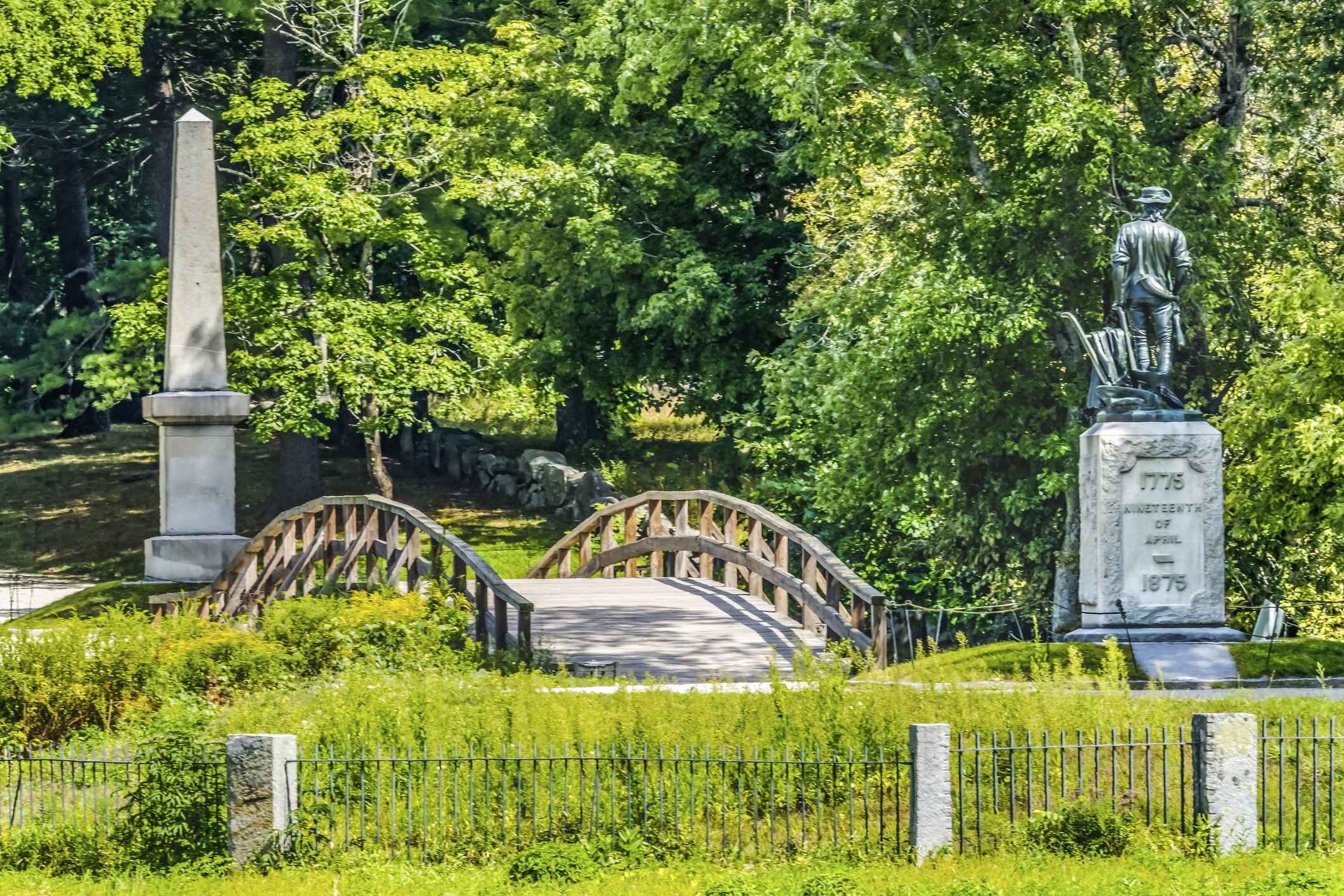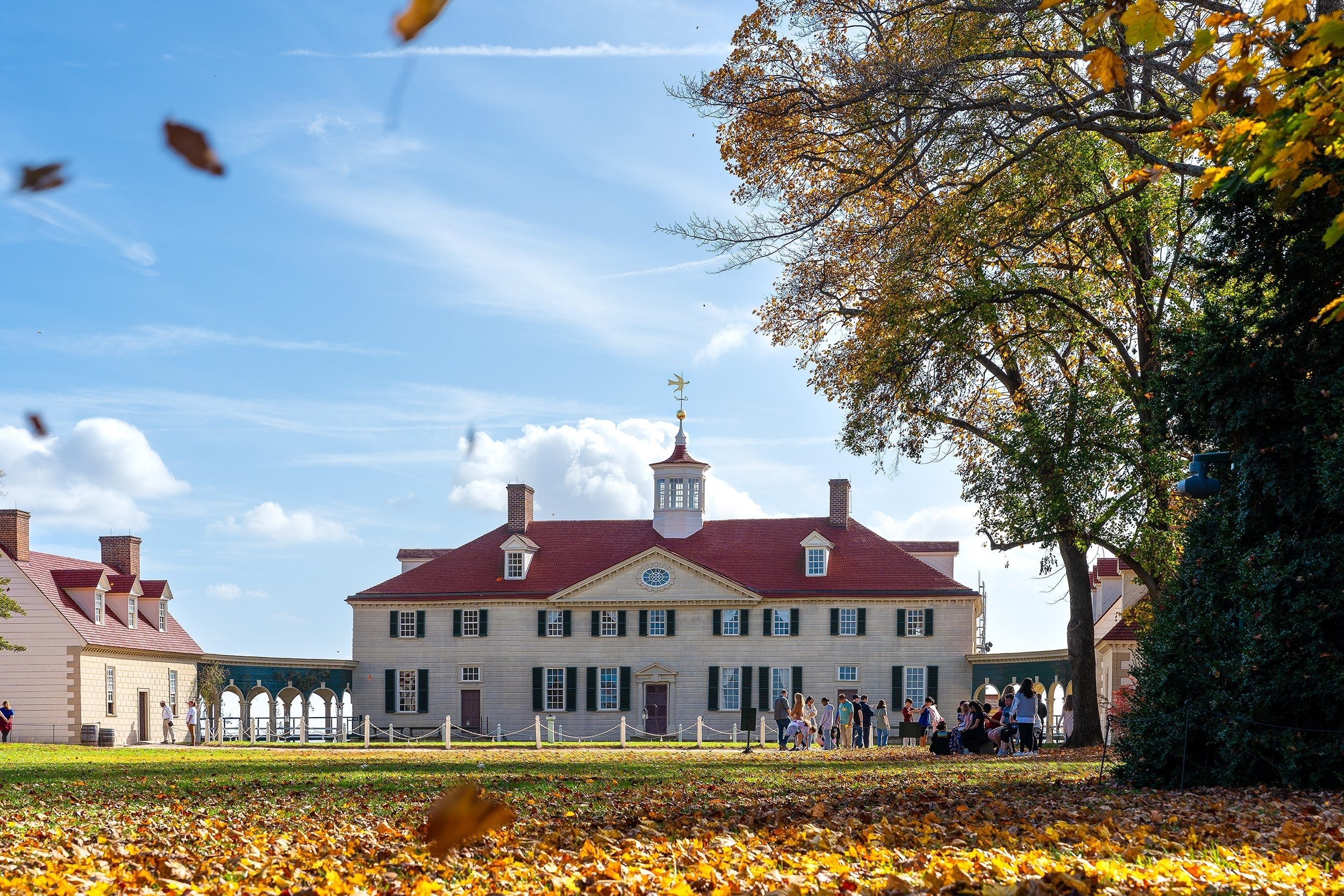Top Ten American Revolution Sites
Edward Percy Moran: Washington at Valley Forge
With the 250th birthday of the United States on the horizon in 2026, there’s never been a better time to visit the key sites of America’s War for Independence.
It all began in Boston in the early 1760s when colonists began agitating for better treatment by the British government, kickstarting a mass movement across 13 colonies up and down the East Coast to press for complete independence from the British Empire. The war that finally began in 1775 would pit American Patriots against King George III and his British redcoats. After eight years of fighting, General George Washington and his rag-tag Patriot army would triumph, driving the redcoats out of the newly formed United States and founding a new republic, the largest anywhere in the world in 1783.
In this article, we introduce you to our top ten American Revolution sites in the eastern United States.
1. Boston’s Freedom Trail
Nestled in the heart of the oldest city in British North America, Boston's Freedom Trail offers a welcoming entry point into the history of the American Revolution, showcasing this New England port’s pivotal role as the cradle of independence. The trail features 16 significant sites, including the Massachusetts State House, the Boston Tea Party Ship and Museum, Paul Revere’s House, and the Old North Church. Each location, some of them iconic landmarks, has its own unique story, and the 2.5-mile trail offers beautiful views of Boston’s charming neighborhoods, from the cobblestone streets of Beacon Hill to the waterfront vista that looks out from the top of the breathtaking Bunker Hill Monument. Many sites offer interactive exhibits and guided tours, allowing visitors to engage with history in a hands-on way. Whether it's climbing aboard a historic ship or exploring a museum, there's something for everyone. Visiting the Freedom Trail offers a perfect blend of history and stunning scenery and after exploring the sites, you can try New England clam chowder (“chowda” as Bostonians call it) at a local eatery or enjoy the famous Boston lobster roll.
2. Lexington & Concord
On April 19, 1775, the opening battles of the American Revolution took place in Lexington & Concord, two historic towns just west of Boston. A trip to Lexington & Concord today is a captivating journey into America’s revolutionary past. The iconic Lexington Green, which now forms part of the Minuteman National Historic Park, is a must-see, the site of the famous “shot heard round the world.” You can stroll the green, imagining the tense standoff between Patriot militia and British troops, while watching reenactments that bring history to life.
Next, Concord’s North Bridge offers a chance to explore the site of the first Patriot victory against British forces. The picturesque scenery makes for a great photo opportunity, and the meadow near the bridge is a perfect spot for a picnic. Don’t miss the chance to interact with knowledgeable park rangers who share fascinating stories and insights. Local shops and eateries provide delicious breaks in your exploration, offering tasty New England treats.
3. Philadelphia’s Old City
Old City is Philadelphia’s historic colonial quarter. Today, Old City is a vibrant tapestry of history, culture, and fun, a must-visit destination in which re-enactors walk the streets ready to take visitors back in time. Snap a selfie with the famous Liberty Bell, an enduring symbol of freedom. Then head over to Christ Church, the Anglican meetinghouse that served as the Sunday gathering place for the signers of the Declaration of Independence. Stop by the Betsy Ross House to learn about the woman George Washington commissioned to create the first American Flag in 1777. Then check out the President’s House Site (“the first white house”), the former executive mansion of George Washington and John Adams, when Philadelphia was the capital of the United States, and end with a stroll past Benjamin Franklin’s gravesite. Try to grab a Philadelphia cheesesteak for lunch as you stroll through Old City’s maze of alleys, stopping at charming boutiques, artisanal shops, and numerous galleries that showcase local artists.
4. Independence Hall
At the heart of Old City Philadelphia stands the building known today as Independence Hall. In July 1776, the site served as the seat of the Patriot government and as home to the chamber where 56 delegates to the Second Continental Congress voted to embrace “life, liberty, and the pursuit of happiness” as the mission of their new nation and adopted the Declaration of Independence as their founding statement. Visitors can stand in the very room where delegates debated Thomas Jefferson’s Declaration (and, later, the 1787 Federal Constitution that established the framework for the government of the United States). To be in the birthplace of American democracy is an exhilarating experience, made all the richer by knowledgeable National Parks Service rangers who bring the history of this iconic symbol of freedom to life. Then step outside to admire the building itself, a stunning example of Georgian architecture, complete with a distinctive clock tower. Independence Hall was designated a UNESCO World Heritage Site in 1979 and preservation efforts have ensured that it remains a vital part of America’s historical narrative.
5. Museum of the American Revolution
The best new museum in the United States is the Museum of the American Revolution, which stands just a block or two away from Independence Hall. The museum is a favorite with historians and casual visitors alike. It is stuffed full of engaging, interactive exhibits that allow museum-goers to step into the revolutionary era including several immersive experiences and life-sized recreations of historic scenes.
The museum also displays a vast collection of rare artifacts, including George Washington’s personal belongings and original documents, and a ‘Revolutionary Garden’ that features plants which were significant during the revolutionary period. The whole experience culminates with a 3D film and dramatic display of Washington’s War Tent, a massive historic structure behind bulletproof glass on the second floor from which the famous Patriot general directed the war effort.
6. Valley Forge
Valley Forge, a huge campsite just west of Philadelphia, was the site of the Patriot Army’s winter encampment in 1777-78. There, George Washington, Alexander Hamilton, the Marquis de Lafayette, and about 10,000 Patriot soldiers and their families spent the bitter winter of 1778, training and drilling to become a professional fighting force and trying to find the resolve to renew their fight against the much larger British army.
It has been an iconic site for the study of the American Revolution ever since - and is enormous. The historic park spans over 3,500 acres of rolling hills, meadows, and woodlands. Visitors can explore reconstructed soldiers’ huts, the Washington Memorial Chapel, and other historic buildings that provide insight into life during the encampment. The newly updated visitor center is also top-notch, boasting engaging exhibits, films, and artifacts that bring the story of Valley Forge Winter to life.
7. Fraunces Tavern
Built in 1719, Fraunces Tavern is one of the oldest buildings in lower Manhattan. It served as a headquarters for George Washington during the American Revolution, and yet somehow remains one of the least well-known major sites from that struggle to survive to the present day. Originally a private home, it was converted into a tavern in 1762 and quickly became a popular gathering place for revolutionaries and patriots. The tavern served as a key meeting place for American revolutionaries, including members of the Patriot Sons of Liberty, and was a venue for discussing strategies and mobilizing support for independence from British rule.
Yet it is best known for hosting George Washington’s farewell address to his officers on December 4, 1783, a poignant moment that marked the end of the Revolutionary War. Today, the tavern’s colonial charm (think wooden beams and cozy fireplaces) is immediately apparent when you step inside. While part of the building is now a museum, the rest operates as a restaurant, offering a diverse menu featuring classic American dishes and craft beers, offering a unique twist to the visitor experience.
8. George Washington’s Mount Vernon
Set along the banks of the Potomac River just south of Washington DC, Mount Vernon is the former home and agricultural plantation of George Washington, the commander in chief of Patriot forces during the war and the first president of the United States. Washington inherited the estate from his father in 1743 and expanded it significantly, transforming it into a thriving plantation by implementing innovative practices, such as crop rotation and selective breeding. Under Washington's direction, the mansion also underwent numerous renovations and the final design reflects his tastes and interests, featuring a distinct Georgian architectural style, complete with a large portico and impressive views of the Potomac River.
After Washington’s death in 1799, Mount Vernon became a site of pilgrimage for those wishing to honor the first president. Today it is the most popular private museum anywhere in the United States, offering excellent historical interpretation, including a notably thoughtful examination of the lived experiences of those enslaved at Mount Vernon and the extraordinary steps they took to claim freedom for themselves during the chaos of the war.
9. National Constitution Center
Philadelphia was the site of the 1787 Constitutional Convention, the nationwide effort to design a new republican system of government for the newly United States. A contentious, long, hot summer of closed-door deliberations eventually produced the United States Constitution, the blueprint for the strong federal government that remains in operation today.
Philadelphia’s National Constitution Center is the nation’s living monument to its revolutionary charter, and features hands-on exhibits which simulate the lawmaking process and explore the Constitution's relevance today....The center also hosts a vast collection of historic objects, including a signed copy of the Constitution. But it is perhaps best known for the way in which it highlights the importance of civic engagement, and encourages Americans to think critically about their rights and responsibilities as citizens.
10. Trinity Churchyard
Established in 1697, New York’s Trinity Churchyard is the final resting place of many several Founding Fathers (and Mothers) from the Revolutionary era, including Alexander Hamilton, the protagonist of the hit musical Hamilton. The church itself is an architectural gem built in the Gothic Revival style. Visitors can admire its design and learn about its role in the community over the centuries - although it is the churchyard surrounding it which draws the most attention.
The churchyard served as a burial site during the British occupation of New York during the Revolutionary War and also served as a meeting point for Americans loyal to Britain (known as Loyalists). Surrounded on all sides today by gleaming skyscrapers, the churchyard remains a serene escape from the bustling city. Located in lower Manhattan, Trinity Churchyard is also near other significant landmarks, including Wall Street and the National September 11 Memorial.
North East USA
Retracting the Revolution
In the company of US historian Prof. Richard Bell, explore key sites in four major North American colonial port cities to understand the causes, course, and consequences of the American Revolution.
Beginning in Boston, the cradle of American Independence, we explore the road to revolution and see how that city remembers its pivotal role. A short flight then takes us to Washington D.C., where we examine the role of slavery and freedom in the famous fight for life, liberty, and the pursuit of happiness. After a visit to the American army’s famous winter camp at Valley Forge, we continue the tour in Philadelphia, the first capital of the United States, before concluding our tour in New York, a centre of commerce which experienced pivotal changes amidst the American Revolution.











